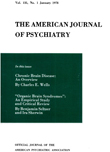DISCHARGE AND READMISSION RATES IN 4,254 CONSECUTIVE FIRST ADMISSIONS OF SCHIZOPHRENIA
Abstract
1. Without exception, each age group has achieved a rising rate of discharge over the 40-year period studied. The most marked rise has been in patients aged 35-49, where the rate has risen from 40% to 74%, and in patients aged 50 and over, where the rate has jumped from 25% to 50%.
2. In the 20 years prior to 1933, males traditionally had a higher rate of discharge than women. Beginning in 1933 the gap gradually closed until 1943-53's admissions saw a complete reversal of the pattern, with women having a higher rate of discharge than men.
3. The readmission rates cannot be fully compared until more time has gone by for recent discharges. However, a figure of some 30% represents the rehospitalization rate during 10 years after discharge for earlier cases. Since the 1943-52 discharges have a first-year readmission rate of 9.6%, there is sound basis for believing that recent discharges are achieving as good or better remissions than patients discharged in former years, and that the final 10-year permanent readmission figure will be 25 to 30%.
4. Studies of this type provide a historical perspective of changes which have taken place in prognosis for the schizophrenic. Such data also provide a useful yardstick for evaluating new therapeutic techniques.
This study, along with others completed and in process at the Warren State Hospital, demonstrates that the old pessimism about schizophrenia is not justified. Three of 4 schizophrenics currently coming to the hospital are being discharged and only 25-30% of currently discharged patients will require permanent readmission.
These studies also seem to contradict the oft-expressed views that shock and other modern therapies have not really effected any change in prognosis for the schizophrenic patient. The figures demonstrate quite clearly a sharply improved outlook. There is no longer any reason for the family physician or the psychiatrist to talk in hopeless terms with the family of the schizophrenic patient. There is every reason to believe that new therapies and improvement of presently available therapies will brighten the already encouraging picture.
Access content
To read the fulltext, please use one of the options below to sign in or purchase access.- Personal login
- Institutional Login
- Sign in via OpenAthens
- Register for access
-
Please login/register if you wish to pair your device and check access availability.
Not a subscriber?
PsychiatryOnline subscription options offer access to the DSM-5 library, books, journals, CME, and patient resources. This all-in-one virtual library provides psychiatrists and mental health professionals with key resources for diagnosis, treatment, research, and professional development.
Need more help? PsychiatryOnline Customer Service may be reached by emailing [email protected] or by calling 800-368-5777 (in the U.S.) or 703-907-7322 (outside the U.S.).



